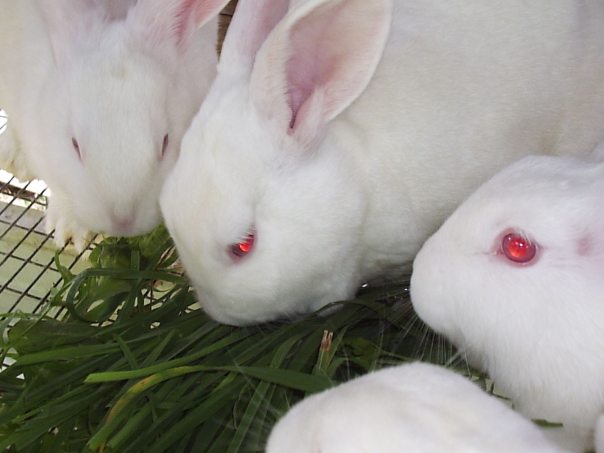Here is a quick list of rabbit terminology you should know when raising rabbits.
Abscess- collection of pus caused by infection
Agouti- A color pattern where each individual hair alternates dark and light bands.
Albino- a white haired rabbit with pink eyes.
Belled ears- Ears that lop over or droop, this is sometimes caused in growing rabbits in hot weather.
BEW- blue eyed white rabbit.
Birthing- see kindling
Breed- Group of rabbits that share the same characteristic’s such as color, size, and fur type
Breeding- When you mate rabbits.
Buck- A male rabbit.
Coccidiosis- Coccidiosis is considered to be the most common disease in rabbits and is very hard to cure. Coccidiosis is caused by a protozoan. There are nine species of this protozoa that can affect rabbits, only one affects the liver, while the other 8 affect the intestines. It seems that younger rabbits have a higher risk for this disease. The disease is spread as the eggs from the protozoa are shed in the rabbit feces, which is then transmitted to other rabbits.
Condition- the general health and appearance of a rabbit.
Colony raising- This system of management is the raising of multiple rabbits together in one area inside or outside.
Crossbreed- breeding rabbits of different breeds.
Culling- Culling is not just the killing of rabbits, but with that being said you do not want to breed or sell to potential breeders, bad rabbits these are to sold as pets only. Save The Best Eat The Rest!
Dam-The mother of a particular rabbit.
Dewlap- Fold of loose skin under the chin of female rabbits.
Doe- A female rabbit.
Dressed- Skinned and prepared for cooking.
Ear canker- Scabby conditions in rabbits ears caused by ear mite.
Enteritis- Is a Intestinal disturbance in domestic rabbits this is caused by stress and or other underlying diseases.
Foster- Fostering rabbit kits is the act of placing newborn baby rabbits with a different mother doe.
Gestation period- The period of time between breeding and kindling. Usually 28 to 31 days.
Heat stroke- Illness caused by exposer to high temperatures
Hock-First joint of the hind leg of the rabbit.
Hutch- Rabbit housing
Hutch card- Information card on cage that identifies the rabbit and contains breeding information
Jacket off – this means the rabbit will be skinned
Kits- A bunch of bunnies.
Kindling- when the doe is giving birth to young.
Lagomorph- There are about eighty species of lagomorph which include thirty species of pika, twenty species of rabbits and cottontails, and thirty species of hares.
Litter- group of baby rabbits born in one birth
Line breeding- this breeding system is usually the most satisfactory. Line breeding itself is a form of inbreeding, but is less intense. In line breeding, rabbits are mated together which are both descendants from a particular rabbit, but which are as distantly related as possible.
Loin-
Malocclusion- The misalignment of teeth, this is genetic and rabbits that have this should not be bred.
Molt- Shedding fur
Mucoid enteritis- Disease that usually affect’s young rabbits, symptom’s are loss of appetite, increased thirst, and jelly like diarrhea.
Nest box- A box to provided for the doe so that she can make a nest and have kits in.
Nesting- when the doe starts to put nesting material in her box.
Outcrossing- is the breeding of two rabbits from unrelated lines.
Palpate- Feeling for the developing embryos within the abdominal cavity of the pregnant doe. This is said to be the most reliable way to determine pregnancy in the domestic rabbits.
Pedigree- Written record of an animals ancestors, going back at least three generations.
Pelt- skin and fur of a rabbit to be tanned.
Purebred- parents are of the same breed
Rabbitry- place were rabbits are kept
REW- Red or ruby eyed white
Saddle- the meaty hind body and legs
Sire- The father of a particular rabbit.
Sired- fathered
Sore hock- a ulcerated condition of the undersurface of the hind feet of a domestic rabbit. Cause by sparse hair on the hocks, this could be genetics or some breeds like rexes have this naturally. Dirty wet conditions.
Tattoo- permanent mark in ear to identify rabbits.
Test breeding- At about two weeks following breeding, the doe is returned to the buck’s cage. If she is bred, she will whine, growl, and flatten herself against the cage floor. She will not be happy to the buck’s advances. This is often the case, but there are does who will breed if pregnant and those who will refuse the buck when they are not.
Trio- 2 does and 1 buck. They are usually matched for breeding to begin or expand a rabbitry.
Type- General physical make up of a rabbit.
Warren- Warrens are a large fenced enclosed area were rabbits can burrow and live as naturally as possible. This is equal to free ranging chickens.
Weaning- When you take young rabbits away from the mother and their transition to solid food.
Wool block- blockage in the digestive tract cause by fur
http://riseandshinerabbitry.com/
.

No comments:
Post a Comment